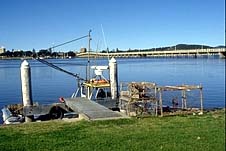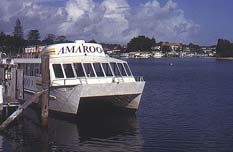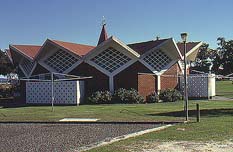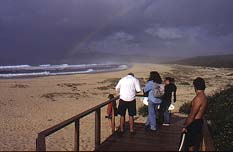
|
| The bridge that separates
Forster and Tuncurry |
Forster-Tuncurry
Twin towns on either side of Wallis Lake. Popular holiday
resort.
Forster and Tuncurry, located 312 km north of Sydney, are
two coastal towns which are now essentially one conglomerate
urban mass separated by a very large concrete bridge. They
sit on opposite sides of the entrance to Wallis Lake which
is 26 km long. Thus the two towns are fronted by the ocean
to the east and the lake to the west. The combined
population is currently 24 000. The endangered bird species,
the little tern, breeds on two of the lake's many islets.
Forster-Tuncurry is a very typical holiday resort with
all the strengths (lots of accommodation, plenty of places
to eat takeaway food and local seafood, good fishing,
surfing and swimming areas, a casual atmosphere) and
weaknesses (it looks as though it was built three weeks ago,
there are plenty of three-storey apartment blocks and little
intimacy) that such resorts have.
Captain Cook and Matthew Flinders sailed by the area in
1770 and 1799 respectively. Two ships were wrecked off Cape
Hawke in 1816, presumably introducing the first white people
to the area. The Captain of one of the ships, his wife,
child and two crew reached Newcastle. The rest were presumed
killed by the indigenous inhabitants of the area.
In 1818, John Oxley and his party, en route to Sydney
after an inland expedition, carried a boat from Booti Booti
to Boomerang Beach where they spent the night. One of the
party was speared by the local Aborigines (the Wallamba, a
sub-group of the Worimi people) who watched them from
canoes. Oxley named Wallis Lake after the commandant of the
penal settlement at Newcastle.
This area was issued as part of the million-acre land
grant to the Australian Agricultural Company (AAC) in 1825
but they found this section of their grant of no use and
exchanged it. Nonetheless, it is said that the Chinese
shepherds hired by the AAC in the 1850s fished off the coast
here and dried their wares for sale to their countrymen on
the goldfields.
Timbergetters investigated Cape Hawke in 1831 and they
appear to have treated the indigenous inhabitants very
badly. They later scoured the rainforests for cedar and pine
using the Wang Wauk River and Wallis Lake to float logs to
the coast.
The first European settlers on the townsite were the
Godwin family who set off from Gosford in 1856. William
Godwin established very cordial relations with the
Aboriginal population and sent wild honey and Cape Hawke
oysters to Sydney. One of his daughters was the first white
person to be born in the area.
The townsite, then known as 'Minimbah', was first
surveyed in 1869 and renamed in 1870 after William Forster -
then secretary of lands. A school opened in 1870 and a pilot
station in 1872. John Breckenridge established a saw mill
(and a store) on the townsite in 1871 and engaged in
shipbuilding as the waterways were virtually the sole means
of transport at the time. In the 1880s he built the biggest
sawmill in the district 15 km north at Failford where he
also built a store (which doubled as a post office) and a
hall.
Other settlers followed and the first hotel was built in
1874 and the first church (Methodist) in 1876, the year the
first constable arrived. A school of arts was built in 1878
and a second store was opened the following year.
Timbergetting, milling, shipbuilding and fishing were the
principal industries in the early days with sailing ships
then steamships carrying fortnightly cargoes to Sydney. The
first oyster lease at Forster was granted in 1884, the year
of a typhoid outbreak at the settlement. A breakwater was
built on the southern side of the Wallis Lake entrance
between 1900 and 1903.

|
| Boats moored at the
Forster Marina in Lake Wallis |
Tuncurry, a good swim away on the other side of the
entrance to Wallis Lake, was known as North Forster until
1875 when John Wright, his foreman, a sawyer and a builder
set up camp there in 1875. They established cordial
relations with the local Aborigines and adopted their
place-name of 'Tuncurry' which is thought to mean 'good
fishing place'. At that time Tuncurry consisted largely of
tea-tree swamp and cabbage tree palms. By 1878 Wright had
established a sawmill, a store, a shipbuilding yard and
houses for his employees. He established a school in what is
now Peel St which was replaced by a government school in
1881 and the settlement's first church (the Latter Day
Saints) opened in the old school room. A Catholic Church was
built in 1888 and a post office opened at Tuncurry in 1889.
The settlement was proclaimed a village in 1893. The first
hotel and hall were built there the following year, an
ice-works in 1895 and a butter factory in 1917. Two Italian
immigrants transformed the fishing industry of Tuncurry in
the 1890s.
With the building of the bridge in 1959 the two towns
blurred with traffic passing easily from one centre to the
other. Prior to the bridge a ferry joined the two towns. The
first such means of conveyance, a rowboat, commenced
operations in 1890. The first vehicular ferry was
established in 1922. Today fishing and oyster leases and
tourism are the mainstays of the local economy.
The International Iron Man Triathlon in April is a
decisive competition drawing competitors from around the
world. The Forster-Tuncurry Fishing Competition and Forster
Cultural Festival are held in June, an open art exhibition
in September, the Oyster Festival and the Open Gardens
Scheme in October, and a market is held at the Forster town
park on the second Sunday of the month.
Things to see:

|
| Forster's elaborate and
unusual toilet block |
Attractions in the Area
One of the town's few claims to fame is a remarkably
elaborate and original toilet near the Caravan Park. It
looks more like a church or a public hall. It even boasts a
weather cock on the roof. On the outskirts of Forster (on
the road to Seal Rocks) is the Curtis Collection of Vintage
Cars.
Tourist Information
The Great Lakes Visitors' Centre is open seven days a week
and is located in Little Street, Forster, adjacent the lake,
tel: (02) 6554 8799 or, toll-free, (1800) 802 692. It
conducts bookings and can provide tourist maps, tide charts
and fishing guides, and information regarding local
attractions, eco tours, walking tours, 4WD tours, boat-hire
services, accommodation, arts-and-crafts shops, antique
shops, coming events, activities, houseboats, diving
packages, horseriding possibilities, ferry services to the
islands of Wallis Lake, National Parks forests and walking
trails, as well as cruises relating to deep-sea fishing,
dolphin-watching, birdwatching and scenic ventures.
The Beaches
The Forster-Tuncurry area has a number of beaches. The Bar
is located at the southern end of Nine Mile Beach which
extends northwards from Tuncurry to Hallidays Point. To get
there, cross the bridge, take the first right into Wharf St,
turn right again at the first main cross street (Beach St)
then take the first right into Rockpool Rd. It is a good
surfing area with a rock pool, grassed areas, a kiosk,
showers, toilets, a childrens' playground, and a pleasant
bathing and picnic area with barbecue facilities. You can
walk out to the end of the breakwater where dolphins can
sometimes be seen at play.
Forster Beach is at the end of Beach St adjacent the
southern breakwater in Forster. Patrolled in season, it has
showers, toilets, a kiosk, picnic facilities and ocean baths
at its eastern edge. Adjacent the baths is Second Head and
on the eastern side of this headland is Pebbly Beach which
is another good surfing spot.
A little further east is The Tanks, an unusual rock
formation where the waves spray water into a protected safe
swimming area.
Further east again, at the end of Bennetts Head Rd, is,
well, Bennetts Head which is named after the family who
built a home at the foot of the headland in 1864. There is a
lookout with views south over One Mile Beach, west over the
hinterland and north to Manning Point. A paved walkway
provides a scenic walk.

|
| Cellito Beach near Smiths
Lake |
Bennetts Head is located at the north-eastern tip of
Forster. The coastline then heads due south and immediately
south of Bennetts Head is One Mile Beach which is a good
surfing location with grassed picnic-barbecue areas, a surf
club, a kiosk, showers and toilets. It is patrolled is
season.
At the southern end of the beach is Burgess Point and on
its southern side is Burgess Beach, a small and quiet beach
accessed by a steep path which runs off Burgess St. It is a
good spot for families with shelter on three sides and
plenty of small rock cave formations.
Surfing can also be enjoyed at Bulls Paddock, which is
part of Seven Mile Beach, south of Cape Hawke.
The Pebbly Beach Bicentennial Walk
The Pebbly Beach Bicentennial Walk commences off North St,
near the ocean baths of Forster Beach. It leads eastwards
over Second Head along the foreshore, between Bennetts Head
Rd and the ocean, past The Tanks, through Bennetts Head
Reserve and south past One Mile Beach to Burgess Beach.

Broadwalk
Business Brokers
Broadwalk Business
Brokers specialise in General Businesses for Sale, Caravan Parks for
Sale, Motels for Sale, Management Rights & Resorts for Sale, Farms for
Sale, Hotels for sale,Commercial & Industrial Properties for Sale.
Phone:
1300 136 559
Email:
enquiries@broadwalkbusinessbrokers.com.au
AUSTRALIAN BUSINESSES FOR SALE
COFFS HARBOUR BUSINESS BROKERS
BROADWALK BUSINESS BROKERS
GOLD COAST BUSINESSES FOR SALE
BRISBANE BUSINESSES FOR SALE
SYDNEY BUSINESSES FOR SALE
CARAVAN PARKS FOR SALE
BUSINESSES FOR SALE
MOTELS
FOR SALE
HOTELS
FOR SALE
Disclaimer
We advise prospective purchasers that we take no
responsibility for the accuracy of any information in the business
provided by vendors or their professional advisers and that they should
make their own enquiries as to the accuracy of this information,
including obtaining independent legal and/or accounting advice
Forster-Tuncurry

